

How the media affects youth. Empowering Adolescents Through Critical Literacy. The 100 Best Young-Adult Books of All Time. We’re living in a golden age of young-adult literature, when books ostensibly written for teens are equally adored by readers of every generation.
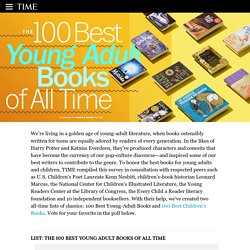
In the… We’re living in a golden age of young-adult literature, when books ostensibly written for teens are equally adored by readers of every generation. In the likes of Harry Potter and Katniss Everdeen, they’ve produced characters and conceits that have become the currency of our pop-culture discourse—and inspired some of our best writers to contribute to the genre. To honor the best books for young adults and children, TIME compiled this survey in consultation with respected peers such as U.S. Children’s Poet Laureate Kenn Nesbitt, children’s-book historian Leonard Marcus, the National Center for Children’s Illustrated Literature, the Young Readers Center at the Library of Congress, the Every Child a Reader literacy foundation and 10 independent booksellers.
LIST: The 100 Best Young Adult Books of All Time Little, Brown. A Tale of Two Teachers. 10. Characteristics of the Literature The 111 articles were found across a wide variety of scientific journals (n = 80).
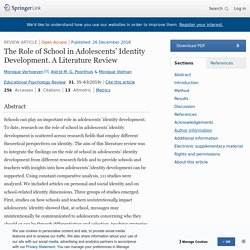
In total, 19 of the 111 articles were theoretical in nature. Among the empirical research papers, six articles were quantitative in nature and another set of seven articles employed a mixed-methods design. Seventy-eight articles exclusively used qualitative research methods and generally presented small case studies. Of these qualitative studies, 60 reported longitudinal research. Theoretical Perspectives on Identity Development Different theoretical perspectives on identity development can be found in the studies included in our literature review. Sociocultural Perspectives Psychosocial Perspectives Psychosocial perspectives are often adopted by scholars whose main focus is on the internal, psychological processes of a person’s identity development (e.g., Negru-Subtirica et al. 2015; Solomontos-Kountouri and Hurry 2008). Social Psychological Perspectives Teaching Strategies. Lesson Plan: Identity: Defining Self, Choosing Friends.
Download the Lesson Plan Jump to: In this lesson, students explore the factors that influence self-identity, which frequently evolves as adolescents negotiate life's circumstances to find and secure their places in the world.
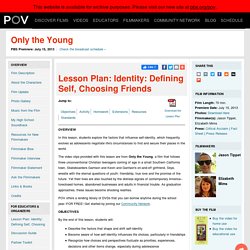
The video clips provided with this lesson are from Only the Young, a film that follows three unconventional Christian teenagers coming of age in a small Southern California town. Skateboarders Garrison and Kevin and Garrison's on-and-off girlfriend, Skye, wrestle with the eternal questions of youth: friendship, true love and the promise of the future. Yet their lives are also touched by the distress signals of contemporary America--foreclosed homes, abandoned businesses and adults in financial trouble.
POV offers a lending library of DVDs that you can borrow anytime during the school year--FOR FREE! By the end of this lesson, students will: Language ArtsSocial StudiesCurrent Events Internet access and equipment to show the class online videoChart paper and markers 1. Lemon Andersen: Please don't take my Air Jordans. Ashweetha Shetty: How education helped me rewrite my life. NPR Choice page. Elevating Student Voice Through Senior Talks. Given the amount of time we’re spending teaching online—and thinking about the upcoming school year—any small steps we can take to make our virtual classrooms more relational, engaging, and supportive are important.
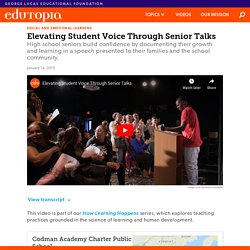
While teachers and students benefit from restorative practices as an alternative to exclusionary discipline practices, they thrive when restorative principles are applied holistically to everything we do in schools—from how we deliver our lessons to the everyday connections we make with our students. In fact, lasting whole-school change requires that we shift from doing restorative to actually being restorative. But what does this look like and sound like in an online class? Covid-19 has brought with it a greater need for this restorative and trauma-informed approach. Even a short pause for a check-in goes a long way to settle the elevated stress levels and experiences of isolation, and this leads to more learning.
Identity SHORT FILM 2012 (Award Winning Inspirational Short) - Vídeo Dailymotion. Discovering My Identity. Language, Class, and Identity: Teenagers Fashioning Themselves Through Language. Identity and Choices. The last two lessons of this unit demonstrated how outside factors such as names, labels, and assumptions can influence identity.
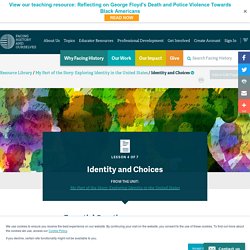
One goal of this lesson is to help students become more self-aware and realize that they have the opportunity to make choices about who they are. Sometimes the choices a person makes, consciously or unconsciously, can affect how others perceive that person. Students will consider how choices—like deciding what to wear in the morning, how to style themselves, or how to present themselves on social media—can emphasize some aspects of their identities while minimizing or hiding others. Sometimes others react to us based on choices we make, and the reactions of others can affect our future choices. This feedback loop can be observed perhaps most plainly in the ways that we create and revise our identities online. The Me I Want You to See. A Call to Action: What We Know About Adolescent Literacy Instruction - NCTE. Chimamanda Ngozi Adichie: The danger of a single story.